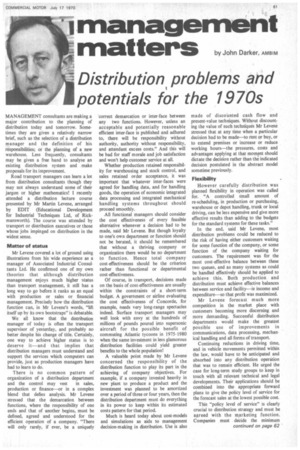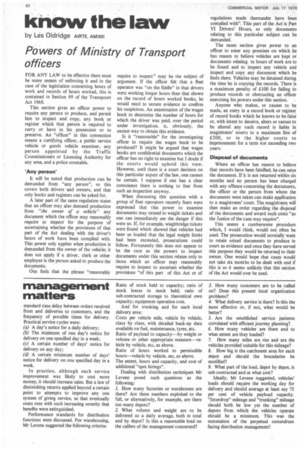*j management
Page 63

Page 64

If you've noticed an error in this article please click here to report it so we can fix it.
matters by John Darker, AMBIM
Distribution problems and potentials for the 1970s
MANAGEMENT consultants are making a major contribution to the planning of distribution today and tomorrow. Sometimes they are given a relatively narrow brief, such as the selection of a distribution manager and the definition of his responsibilities; or the planning of a new warehouse. Less frequently, consultants may be given a free hand to analyse an existing distribution system and make proposals for its improvement.
Road transport managers can learn a lot from distribution consultants though they may not always understand some of their jargon or higher mathematics! I recently attended a distribution lecture course presented by Mr Martin Levene. arranged by EDIT (Educational Development for Industrial Techniques Ltd, of Rickmansworth). The course was attended by transport or distribution executives or those whose jobs impinged on distribution in the widest sense.
Matter of status
Mr Levene covered a lot of ground using illustrations from his wide experience as a manager of Associated Industrial Consultants Ltd. He confirmed one of my own theories that although distribution management enjoys much higher status than transport management, it still has a long way to go before it ranks as an equal with production or sales or financial management. Precisely how the distribution function can, in Mr Levene's words, "lift itself up by its own bootstraps" is debatable.
We all know that the distribution manager of today is often the transport supervisor of yesterday, and probably no better despite his change of title. Certainly, one way to achieve higher status is to deserve it—and that implies that distribution managers must understand and support the services which computers can provide, just as production managers have had to learn to do.
There is no common pattern of organization of a distribution department and the control may vest in sales, production or finance—or in a complex blend that defies analysis. Mr Levene stressed that the demarcation between functions, where the responsibility of one ends and that of another begins, must be defined, agreed and understood for the efficient operation of a company. "There will only rarely, if ever, be a uniquely 'correct demarcation or inter-face between any two functions. However, unless an acceptable and potentially reasonable efficient inter-face is published and adhered to, there will be responsibility without authority, authority without responsibility, and attendant excess costs." And this will be bad for staff morale and job satisfaction and won't help customer service at all.
Whether production retained responsibility for warehousing and stock control, and sales retained order acceptance, it was important that whatever inter-faces were agreed for handling data, and for handling goods, the operation of economic integrated data processing and integrated mechanical handling systems throughout should proceed smoothly.
All functional managers should consider the cost effectiveness of every feasible alternative whenever a decision had to be made, said Mr Levene. But though loyalty to one's own department or function should not be berated, it should be remembered that without a thriving company or organization there would be no department to function. Hence total company cost-effectiveness should be the criterion rather than functional or departmental cost-effectiveness.
Of course, in transport. decisions made on the basis of cost-effectiveness are usually within the constraints of a short-term budget. A government or airline evaluating the cost effectiveness of Concorde, for example, needs very long-range spectacles indeed. Surface transport managers may well look with envy at the hundreds of millions of pounds poured into supersonic aircraft for the possible benefit of commuting Atlantic tycoons in 1975-1980 when the same investment in less glamorous distribution facilities could yield greater benefits to the whole population!
A valuable point made by Mr Levene concerned the responsibility of the distribution function to play its part in the achieving of company objectives. For example, if a company invested heavily in new plant to produce a product and the investment was planned to be amortized over a period of three or four years. then the distribution department must do everything in its power to keep within its estimated costs pattern for that period.
Much is heard today about cost-models and simulations as aids to management decision-making in distribution. Use is also made of discounted cash flow and present-value techniques. Without discounting the value of such techniques Mr Levene stressed that at any time when a particular decision had to be made—to rent or buy, or to extend premises or increase or reduce working hours—the pressures. costs and advantages applying at that moment should dictate the decision rather than the indicated decision postulated in the abstract model sometime previously.
Flexibility
However carefully distribution was planned flexibility in operation was called for. "A controlled small amount of re-scheduling, in production or purchasing, warehouse or depot handling, trunk or local driving, can be less expensive and give more effective results than adding to the budgets for the standard systems for these tasks."
In the end, said Mr Levene, most distribution problems could be reduced to the risk of having either customers waiting for some function of the company, or some function of the company waiting for customers. The requirement was for the most cost-effective balance between these two queues, and as many systems as could be handled effectively should be applied to achieve this. Both production and distribution must achieve effective balances between service and facility—ie income and expenditure—so that profit was maximized.
Mr Levene forecast much more competition in the market place with customers becoming more discerning and more demanding. Successful distribution departments would make the greatest possible use of improvements in communications, data processing, mechanical handling and all forms of transport.
Continuing reductions in driving time, and in vehicle movements permitted within the law, would have to be anticipated and absorbed into any distribution operation that was to remain efficient. He urged the case for long-term study groups to keep in touch with all relevant technical and legal developments. Their applications should be combined into the appropriate forward plans to give the policy level of service for the forecast sales at the lowest possible cost.
This "policy level of service" is clearly crucial to distribution strategy and must be agreed with the marketing function. Companies must decide the minimum standard time delay between orders received from and deliveries to customers, and the frequency of possible times for delivery. Practical service cycles were; (a) A day's notice for a daily delivery; (b) The Minimum of one day's notice for delivery on one specified day in a week; (c) A certain number of days' notice for delivery on any day; (d) A certain minimum number of days' notice for delivery on one specified day in a week.
In practice, although each service improvement was likely to cost more money, it should increase sales. But a law of diminishing returns applied beyond a certain point to attempts to improve any one system of giving service, so that eventually costs rose with such increasing severity that benefits were extinguished.
Performance standards for distribution functions were discussed. For warehousing, Mr Levene suggested the following criteria: Ratio of stock held to capacity; ratio of stock losses to stock held; ratio of sub-contracted storage to theoretical own capacity; equipment operation cost.
And for trunking and for each local delivery area: Costs per vehicle mile, vehicle by vehicle, class by class, with detailed back-up data available on fuel, maintenance, tyres, etc. Ratio of payload to capacity—by weight or volume or other appropriate measure—vehicle by vehicle, etc, as above.
Ratio of hours worked to permissible hours—vehicle by vehicle, etc, as above. The extent, hours and capacity, and cost of additional "spot hirings".
Dealing with distribution techniques Mr Levene posed such questions as the following:
I. How many factories or warehouses are there? Are these numbers exploited to the full, or alternatively, for example, are there too many depots?
2. What volume and weight are to be delivered as a daily average, both in total and by depot? Is this a reasonable load on the calibre of the management concerned?
3. How many customers are to be called on? Does this present local organization problems?
4. What delivery service is there? Is this the Most effective or, if not, what would be better?
5. Are the established service patterns correlated with efficient journey planning?
6. How many vehicles are there and to what extent are they loaded?
7. How many miles are rim and are the vehicles provided suitable for this mileage?
8. How big is the catchment area for each depot and should the boundaries be modified?
9. What part of the load, depot by depot, is sub-contracted and at what cost?
Ideally, Mr Levene suggested, vehicles' loads should require the working day for delivery and should average at least say 75 per cent of vehicle payload capacity. "Interdrop" mileage and "trunking" mileage should both be low yet the number of depots from which the vehicles operate should be a minimum. This was the summation of the perpetual conundrum facing distribution management!








































































































